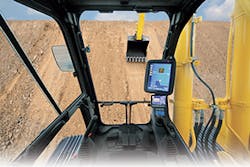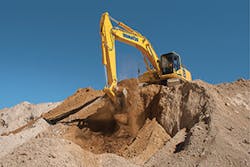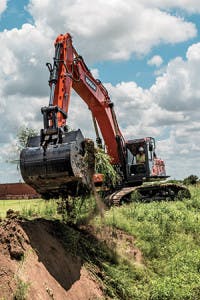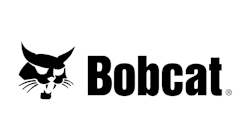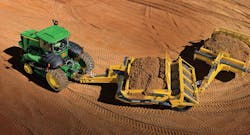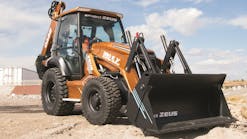Since the mid-1950s, the Highway Trust Fund has been financing road construction and surface transportation projects, both new construction, and expansion and refurbishment of our aging highway infrastructure, its coffers filled by a federal fuel tax and other monetary transfers. The Federal Aid Highway Act of 1956 established the Highway Trust Fund and directs that the fuel tax is to be used exclusively for highway construction and maintenance. These typically short-term projects require large excavators to move a lot of material as quickly as possible.
“When you’re looking at large earthmoving excavators, you’re typically looking for pure speed and power,” says John Bauer, brand marketing manager with CASE Construction Equipment. “The goal is to perform repetitive cycles in as short and compact of an envelope as possible. You want a fast machine that is easy on the operator and that can handle digging with larger buckets that will, in turn, help fill trucks and trailers faster.”
In Control
Operators also prefer smooth, responsive controls that don’t require much overcorrection or repositioning when they swing the boom to dump a load. Bauer says CASE’s two new excavators–the CX490D and CX500D (the largest Tier 4 Final excavator in the D Series and a dedicated model for mass excavation)–serve the mass excavation and production earthmoving market with additional speed and enhanced performance.
“We beefed up the arm and boom to help support greater power and digging capability,” he lists. “We built a stronger undercarriage with thicker components to support production demands. We implemented a new electronically controlled pump, a larger control valve, and added multiple sensors that help ensure all engine and hydraulic power is used efficiently–both improving performance and improving fuel efficiency.”
But the heart of these machines, he says, is the CASE Intelligent Hydraulic System. “This system relies on multiple integrated control systems to make the best use of the machine’s hydraulic power and momentum, resulting in excellent speed, power, and fuel efficiency.” It constantly monitors operator and environmental input, and intelligently redirects hydraulic oil and power to where it is needed most, based on function.
New to Volvo’s arsenal of fuel-efficient design elements is a redesigned, fully electro-hydraulic control system. “Where previous hydraulic control systems created staggered flow effects as operators moved between work modes, the new hydraulic control system creates a smooth pump flow as operators move between modes, creating stronger controllability, higher productivity levels, and fuel efficiency gains,” says Rob Palermo, product manager, GPE Products, Volvo Construction Equipment.
Caterpillar puts operators in control of grade and slope with Cat 2D Grade on large F Series excavators. “Simply set your depth and slope targets, and the monitor will tell you how much to cut or fill,” explains Ryan Neal, product application specialist. An audible alert signals when to stop.
Cat Grade with Assist was introduced on the 323F in 2016 and will be offered on additional models in 2017. The system automates movements typically done by the operator with manual controls. “Where it really shines is on that final pass when you need to reach the perfect depth and slope to avoid costly rework,” says Neal.
Cat 3D is suitable for projects that require ultra-precise cuts and contours. The system features a colorful display that shows operators where to work and how much to cut or fill, eliminating the need for staking and grade checking.
Operators used to have to read grade stakes to indicate target grade. This method often required frequent checks and rework to arrive at finish grade. Today, grade and real-time position information is at the operator’s fingertips in the cab on excavators with Komatsu’s intelligent machine control technology, says Sebastian Witkowski, product marketing manager for intelligent machine control products.
“Our intelligent machine control technology provides major productivity gains—from rough, to finish grade,” he states.
A Komatsu PC360LC in action
Three excavators with this technology are available—from the 158-hp PC210LCi-10 introduced in 2014, to the 359-hp PC490LCi-11. “It’s intuitive, with easy user interface. These excavators allow the operator to dig straight to grade, preventing them from digging past,” continues Witkowski. “There’s no grade checker needed. Get it right the first time; there’s no need to move dirt twice.” He estimates that this technology results in up to 66% reduction of construction time.
Efficiency
With the cost of fuel at a low rate, productivity is an area manufacturers are focused on. Operators want faster cycle times for loading trucks and trenching. Cat Payload, available on several models, provides real-time payload weigh in the cab to improve job-site productivity. Site managers can monitor production remotely with automated tracking, enhancing efficiency.
CASE added two new crawler excavators to its D Series: the CX290D and the CX500D. Both are designed for heavy excavation and provides significant operational gains, such as cycle times up to 10% faster, improved responsiveness, and multifunctional controls for greater fuel efficiency. An electronically controlled hydraulic pump and larger control and solenoid valves boost breakout forces, increase lifting strength, and improve responsiveness.
Volvo’s EC750E features the latest 516-hp Volvo Tier 4 Final D16 engine, which boasts an 11% improvement to horsepower while reducing fuel consumption by 5%. When combined with larger-diameter boom cylinders and increased working pressure, the EC750E delivers a 7% increase in digging force and a 4% boost in hydraulic flow, says Palermo.
“The reinforced booms and arms, designed for durability with high-strength tensile steel, allow customers to select the exact combination of forces that will get the job done in less time at less cost,” he says.
For added protection and reliability in severe conditions, steel strips are welded under the arm, and a built-in, heavy-duty plate is featured on the underside of the machine.
Kobelco’s KOMEX telematics enables contractors to manage their fleet remotely and efficiently—says George Lumpkins, national service manager for KOBELCO USA—monitor operational data to boost productivity, and track location and fuel consumption to maximize machine availability and reduce costs.
Volvo’s EC750E boom and arm
It’s a Mode, Mode, Mode World
Operators can alter how they control the machine by choosing from different modes, says Aaron Kleingartner, marketing manager at Doosan. Doosan excavators have incorporated modes for digging, lifting attachments.
“There’s a rotary dial with four modes: fuel economy, standard, power, and power-plus. Multifunction allows for more precise control. It’s more efficient and productive.”
Multifunction performance leads to productivity increases. Komatsu predicts up to 12% increase in productivity for 360, and up to 4% increase on the PC490 with the new machine updates, claims Justin Lantin, product marketing manager for large excavators. “Six working modes provide a lot of flexibility for the operator,” he says.
Improving control while reducing total energy use is the key. CASE’s efficiency controls fall into one of four categories:
- Boom Economy Control, which reduces RPMs during boom down and swing
- Auto Economy Control that lowers RPMs during idle and automatically shuts down the engine after a preset idle time
- Swing Relief Control, which reduces hydraulic power at the swing start
- Spool Stroke Control, which adjusts hydraulic pressure during digs
Using improvements to the Spool Stroke Control system, D Series excavators also reuse hydraulic fluid whenever possible to automatically increase cycle times and efficiency. The operator experiences a more productive machine without losing the precision of the machine’s controls, helping achieve that fast, powerful, and smooth performance.
With Volvo’s unique ECO mode system, operators select the best work mode for the job at hand—Idle, Fine, General, or Heavy. ECO mode optimizes the hydraulic system to reduce loss of flow and pressure, a power- and fuel-saving option.
The CASE CX490D and CX500D excavators also provide the operator with three working modes–Speed Priority, Heavy, and Automatic–that help the machine conserve energy and exert only as much power as needed to complete the job at hand.
Similarly, KOBELCO excavators feature technology to supply the right balance of fuel economy and performance, Lumpkins says. “H-Mode is ideal for heavy-duty jobs when a higher performance level is required, while S-Mode can be used to reduce fuel consumption during standard operation. And with a light workload, the ultra-efficient ECO-Mode makes low fuel usage a priority; engine control and hydraulic pressure in ECO-mode creates significant fuel savings while optimizing job fuel to production efficiencies.”
R&D for Now and Later
Fuel efficiency and productivity are areas where the manufacturers continue to seek improvements. “We’re still trying to fine-tune the engine to lower fuel consumption,” says Lantin. “It’s a balance between the engine and the hydraulic pumps.”
CASE concentrates on the relationship of the engine, hydraulics, and electronics. “With the extensive focus on emissions controls built into recent generation machines, it’s that integration of systems that has allowed for increased operating capacities and greater fuel efficiency,” explains Bauer.
The addition of more electronics throughout the system is what paves the way for added telematics and machine control functionality. “Ultimately, that’s our focus–helping equipment owners lower their total cost of operation through the integration of these systems,” continues Bauer. “We try to think of the machine as the platform that gives the contractor the ability to do work.”
Although equipment costs increased during the Tier 4 era, these advances have actually helped reduce total cost of ownership and operation by creating greater efficiencies. Faster speeds equate to greater productivity. Greater productivity creates the opportunity for more work.
Bauer believes that the newer excavators on the market today provide greater opportunity and capability to do work in the same footprint owners have always had, and to do so for less. “Simple and easy service, with practical emissions solutions that don’t require intensive maintenance activities [and] help increase uptime and reliability,” he says. “The efficiencies achieved by the hydraulics integration and our emissions solution on these excavators help drive down fuel costs.”
The next level of technological improvement is connecting all assets to improve overall job-site efficiency, Neal predicts. “Cat Connect is already improving the area of big data and telematics with VisionLink.”
The Doosan DX530LC at work
VisionLink is a tool that tracks the location of assets, monitors and manages fuel consumption, identifies operators who may need some extra training, plans and schedules maintenance, and maximizes uptime to move more material and help save time and money.
Komatsu offers a similar system. The Komtrax system comes standard on all dash-11 models. “It’s an enhanced version of telematics that records idle time, work time, productivity, and detects the location of the machine,” says Lantin.
It monitors maintenance, abnormality codes, and regens, providing daily reports to help operators manage costs. “A customer in Tennessee uses a Komtrax reports to monitor the load on his hydraulic breaker,” he says. “The information helps with invoicing and machine costs.”
There will be increased automation in the future, Witkowski foresees. More machine control, more data.
But, performance is still important. The Generation 10 KOBELCO excavators feature a new hydraulic regeneration system, which aids the arm by reusing force generated by the boom to further minimize energy loss and ensure superior performance.
“And,” adds Lumpkins, “the engines on Generation 10 models incorporate a selective catalytic reduction system with diesel particulate filters to decrease NOx emissions and provide the lowest possible operation costs.”
Emissions is an aspect Caterpillar is also working on. Neal says Cat machines are at the forefront in emissions technology. In fact, Caterpillar introduced an engine designed to meet Stage V emissions standards. The C9.3B engine also features an advanced fuel system to improve power, efficiency, and cold start capability. Other Stage V engines include the C2.8, C3.6, and C13 ACERT.
“We are ready to meet the challenge for today and tomorrow,” he says.
Safety First
The top need, claims Kleingartner, is a safe work environment. Contributing to that, Doosan recently enlarged not only the cabs, but also the glass in the cab for enhanced sight lines. The introduction of rearview and side view cameras helps operators to see what’s around them.
“It’s hard to see out the right side,” explains Kleingartner.
Other manufacturers are “seeing” the importance of visibility. KOBELCO Generation 10 excavators feature a rear view and right side camera to provide improved visibility and ensure safe operation.
CASE D Series excavators feature best-in-class cab space with excellent visibility, enhanced by a standard rearview camera, which feeds a 7-inch widescreen monitor that also provides operators with real-time access to important performance parameters, including fuel consumption, operating hours, and machine information. Other safety features in the D Series include a pressurized and iso-mounted cab that keeps noise and vibration down, and a standard Bluetooth radio that provides hands-free functionality.
Komatsu offers a new rearview camera for “visibility at all times,” says Lantin. The dash-11 series also offers other operator protection features, including an auto-lock lever function that activates the joystick control.
“This function will disable the work equipment controls if the lock lever is activated while the joysticks are out of neutral position,” he says.
There’s also a safety feature for digging. If an operator knows underground utilities exist at a certain elevation, they can set a higher artificial elevation to prevent over digging. “It’s a safety net,” explains Witkowski.
And, it’s critical to keep operators safe. Cat machines do this with several standard built-in features, like serrated steps, hand- and guardrails, roll-over protective structure cab, mirrors and rearview camera, and bolt-free service platforms with antiskid plates. Neal says that more safety features are being developed to make sure owners of Cat equipment stay secure.
Several improvements to serviceability and safety have also been made to Volvo’s EC750E, including an optional auto lubrication system, which precisely supplies the correct lubrication to all greasing points (except the undercarriage) at predetermined time intervals. Handrails have also been made more visible with accent colors, and anti-punch slip plates provide superior grip and safety. While helping ensure a safer operation, these elements also have practical benefits like easier cleaning and increased cooling performance.
Ongoing R&D on all excavators seeks to hone the incremental improvements being continuously incorporated into these big earthmovers, thereby reducing costs and simultaneously increasing productivity and efficiency.